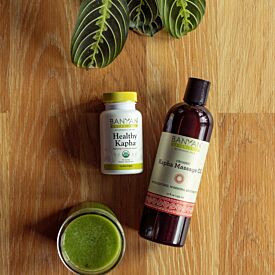The Joy of Enough: Cultivating True Abundance in a Materialist World through Ayurveda
After living in New York City for ten years, I’d developed a rather light hand when it comes to grocery shopping. Places to buy food are basically on every corner, whether it’s a high-end organic chain or a family-owned bodega. With my itinerant schedule and small apartment, it’s always been easier to pick up food for a few days at the most, sometimes even just for a single meal.
One of the reasons the arrival of COVID was so utterly unnerving for me was how quickly I had to modify my shopping habits. When stores were declared viral warzones and I had no reason to go outside on my daily commute, gathering small bits of food here and there was no longer an option.
Instead, I had to channel the memories of shopping with my mom in big box stores when I was young. Suited up in my protective gear, I ventured out to get my sustenance, often waiting hours in line outside the store for my turn, then schlepping two weeks’ worth of food home on foot.
These minor discomforts aside, I’ve been fortunate to have access to almost everything I need during these trying times. But waiting in that grocery store line and hearing stories of toilet paper hoarding and other ongoing supply shortages due to the pandemic, I sensed the visceral fear people had of what would happen if they didn’t have what they needed—a fear I could feel even behind a mask.
A May 2021 McKinsey Survey1 showed online credit-card shopping increased 35 percent from January 2020 to January 2021 and that post-pandemic, 50 percent of Americans expect to spend extra by splurging or treating themselves, especially high-income millennials.
If you peel back the layers of history, it’s no surprise that our shopping habits changed radically during the pandemic.
Beginning in the early 1900s, with the invention of the public relations firm2 (aka advertising and marketing) by Edward Bernays, we’ve been fed a narrative that the way to happiness, and even health, is through more stuff. Got a problem? Buy this thing—it will make you feel better, prettier, and more popular. (Bernays was Sigmund Freud’s nephew, by the way, which is partly where some of this subconscious manipulation is coming from.)
At the core of this strategy are very real things all people need—love, connection, belonging, and acknowledgment.
During the pandemic, the absence of meaningful connection, along with a devastating loss of life, led to a natural urge to compensate with things.
Although I’m a minimalist at heart, during isolation I’d jump up with excitement at the sound of a delivery truck arriving with something new I’d ordered. That moment not only broke up the monotony of another day of Zoom and yoga pants, but if I were lucky, I’d also get a glimpse of the delivery person, maybe even give them a wave as they skittered back to their vehicle.
Buying was an excuse to feel part of the world and hang onto the vestiges of a life I once had that was slowly fading from my memory. Now that we’re emerging from this period of turmoil, however, we might be having some buyer’s remorse.
As we look to rebuilding our lives post-pandemic, we might find that some of our tastes—in things, work, relationships, and experiences—have changed. Indeed, alongside spikes in shopping have come spikes in interest in nature and a desire for more freedom in one’s schedule.
Rather than getting a thrill from window shopping in Manhattan (where I’ve only set foot a handful of times since the shutdown), I now look forward to my daily walks in the park, where I greet my favorite trees and track with fascination the blooming of my neighbors’ rose bushes.
I’ve settled into a daily rhythm of movement, eating, working, and resting that my body feels happy about—an Ayurvedi’s dream dinacharya.
I know I am very privileged in being able to work from home and enjoy these pleasures, but the tenets of Ayurveda are at the forefront of my mind as I reimagine society post-pandemic. Consider this sloka about the ingredients we need for a successful life:
Dharma artha kāma mokṣāṇaṁ ārogyaṁ mūlamuttamam | rogastasya apahartāraḥ śreyaso jīvitasya ca ||
Good health is the root of righteous living, acquirement of wealth, gratification of desire, and final liberation. Diseases are destroyers of health, well-being, and life itself.
What this suggests is quite the opposite of the materialist narrative we’ve been told. Rather than needing the wealth (artha), fulfillment of desire (kama), and the perfect job that is our true “calling” (dharma) to achieve well-being, we need health to provide the foundation of all those sensual, yet ultimately impermanent, experiences that add up to our life.
Like with most things in the Ayurvedic worldview, there’s no either-or when it comes to health versus the materialist concepts of wealth and desire. Rather, it’s both-and—a middle path that asks us to take a look at what’s on our plate (literally and figuratively) and evaluate if it’s what we truly want and what will give us long-term, satisfying energy and nourishment.
When we apply Ayurveda to our materialist world in this way, we’re able to spark a different kind of joy from our things—the joy of enough.
You Are What You Buy
You are likely familiar with best-selling Japanese author Marie Kondo, who famously asks us to evaluate whether our material belongings “spark joy.” If you hold an old sweater or set of dishes in your hands and get a zing of positive energy, then you should keep it even if you’ve got others just like it. On the other hand, if you hold it and think “meh,” it might be time to let that item go and make space for something else—or nothing at all.
This process is very similar to how we understand digestion in Ayurveda. You might even consider that spark of joy as a “gut feeling”! The original form of consumption, eating food requires a number of different processes in our bodies to flow and communicate in order to break down, transform, and absorb nutrition into energy.
There’s our digestive fire, or agni, which involves aspects of all three doshas—the wind of vata to stoke the fire of pitta, and the water of kapha to keep the fire in check. On top of that, we use our five senses to engage with our food on a whole-body level, such that our digestive process is complete and undistracted.
Consider a bowl of your favorite meal, delicious and freshly made—imagine that you can taste it, smell it, see the colors, hear it cooking on the stove, and feel the texture in your mouth. Eating mindfully in this way not only makes for a more pleasurable meal, but it protects agni from being pulled away to digest other stimuli—like our devices or a conversation.
If our senses are consumed by external stimuli while eating, or for too much of our day in general, our agni starts to fade and can’t do its job to digest food. Over time, this can result in disease.
We won’t be getting enough nutrition and that undigested food will build up in the system as ama, which then further blocks our senses from experiencing the world around us. Hence why the sloka above names disease as a “destroyer of life itself.”
You’ve likely experienced this on an individual basis at some point in life. Consider how you feel when you’re unwell or stressed out. Do you want to wear a nice outfit or have a yummy meal? Do you have the energy to go out with friends or do the work you feel passionate about? You can’t experience those four tenets of life when you’re sick, so your mind and spirit suffer as much as your body.
We’ve also seen the harm done when ama builds up globally—through a worldwide virus—one where those with chronic lifestyle diseases were most vulnerable, as a product of our disconnection with each other and our natural cycles and habits.
The measures we’ve had to take to control COVID have also taken us away from the abundance of life we need in balance as much as health—financial security, human connection, and a sense of joy and pleasure in our existence.
That means applying the skills of mindful eating to more than just what’s on our plates.
Ayurveda might tweak the saying “you are what you eat” to “you are what you digest.” If this is true, and our daily consumption includes constant reminders that you’re not enough unless you buy this thing, follow this person, or change yourself in some way, it’s no wonder our digestive systems are sick!
Thankfully, Ayurveda offers us plenty of tools to restore the vitality of our agni and connect to our senses. With practice, we can learn to rely with confidence on our body’s cues to tell us when we’re truly content with our consumption, and when we’ve had enough—of anything.
Turning our focus inward to evaluate the health of our bodies and our spirits, which we feed through our values, activities, and relationships, we move more into the state of mindfulness that allows us to experience joy and pleasure on a deeper level.
After all, it’s not things outside of us, but our subjective, digestive experience inside of us that allows us to be nourished by the pleasures of our sensing body, as well as cultivate the capacity and freedom to know when the quality and quantity of our consumption is just right.
If you’re looking to change your relationships to things or shopping for any reason, consider how the worldview of materialism might be affecting your sensory digestive capacity.
Applying the rituals and routines of mindful eating from Ayurveda to your engagement with all the things that consume your attention, you might find yourself “eating” a very different diet—one that’s tasty, connected, meaningful, and deeply fulfilling.
The following five categories of nourishment correlate to the five senses and Ayurveda’s five elements—ether, air, fire, water, and earth. Through the Ayurvedic lens, we’ll take a look at how we can receive true contentment and satisfaction from what we take in, rather than getting caught in the endless and insatiable search for more.

Communication (Sound/Ether)
Thanks to technology, we have countless ways to communicate with each other. Our computers, phones, and other devices have been a saving grace during the isolation of the pandemic. But this nonstop connection has also left many feeling depleted by screen time as well as a new expectation of being on call for work long past the close of business.
With most of our lives happening online, the tools we use to communicate have become largely transactional, rather than reciprocal—ways of trading our services, time, and attention rather than being fueled by companionship or meaningful information.
At the same time, these interactions are also devoid of the context in which we were designed to communicate. Taking place behind screens or flattened into two-dimensional videos, we’re lacking the help of body language, intonation, and other clues about how we should understand the words coming into our ears.
Think about how many times you misinterpreted a text that wasn’t laden with exclamation points or emojis as cold or rude. Relying mostly on digital connections is also starving us of the rich interactions we have in a shared space—even when we are silent together.
Reclaiming meaning through our digital communication isn’t impossible. In fact, the abundance of technological tools gives us an opportunity to be even more intentional about how and when we stay in touch.
By replacing some or even most of your texts with calls, for example, you’ll be nourishing multiple elements at the same time through the power of sound. Consider the famous studies by Dr. Masua Emoto on how the molecules of water in plants (which we humans also have in abundance in our bodies) are affected by sound vibrations.
In the same vein, choosing social media and other digital “feeds” (an interesting application of this word, eh?) that encourage positive self-talk, rather than disparaging or comparative internal monologues, or dialogues that teach you something rather than only selling you things will allow you to make the most of our worldwide web.
Clothing (Touch/Air)
We often look at the skin in Ayurveda as an indicator of deeper imbalances. Dry skin might mean there’s excess vata, whereas red and irritated skin might reveal more pitta, even if other systems (like digestion) seem to be doing okay.
The clothes we wear are like another layer of skin—one we choose and curate as a reflection of how we might feel. Clothes can also convey the impression we want to make to the world or allow us to do an activity well.
Playing with our clothing style can be a fun and functional part of our daily routine. But materialist culture has turned this form of expression into one of the most harmful, mindless, and sometimes exploitive forms of consumption—one that’s hurting us and the planet.
The garment industry is a huge contributor to both labor inequality and climate change worldwide, as Maxine Bedat explains in detail in her book Unraveled. 3 If we’re not mindful of the clothes we choose to add to our closet, the energy we take in through our skin when we get dressed is likely less than nourishing.
There’s nothing wrong with enjoying trendy styles and giving yourself the occasional makeover—even our physical skin gets a cellular turnover every seven years. But allowing your clothing to be a source of sattvic nourishment, respectfully sharing resources with the earth, minimizing waste, and recycling good prana through how you live our life in those clothes, might inspire a new you to settle into a “look” that will bring you longer-term utility and joy.
The rise in popularity in second-hand clothing is a good indicator that we are collectively shifting our fashion diets to being more sattvic. But when you practice mindful shopping for clothes from the beginning, choosing the fabrics, colors, and cuts that make you feel your best in your actual skin (think of it as abhyanga you can wear!), your closet will feel like it’s overflowing with abundance, even with fewer actual pieces.
Try wearing only your favorite, most comfortable clothes for a whole week. Make note of their color, material, any story or memory you have associated with them, and how you feel while wearing them. Now, imagine if all you owned were clothes you considered your favorite and most comfortable.
Before you go all KonMari on your closet, pause. Look at ways you can repurpose and restyle what you already have. Or share some clothes with others directly rather than having them disappear in a donation box. Then take a moment to enjoy the space you have created by clearing your closet and lightening your load!

Media (Sight/Fire)
Media is undoubtedly one of, if not the, main driver of the materialism machine. Increased exposure to media through the Internet, especially since the pandemic, is making it increasingly difficult to direct our sight inward rather than outward.
When our eyes are receiving information all day and night, it’s like living in a world with constant daylight, and no periods of darkness for rest and rejuvenation.
This nonstop availability of media (and pressure to contribute to the dialogue) can be a major source of stress and depletion that affects our mental and physical health, digestive capacity, and alignment with a healthy circadian rhythm.
That, on top of the dominance of hurtful, violent, upsetting, or divisive content being shared, can make the wide world of the Internet seem like a true Pandora’s box—and the source of a fight-or-flight stress response.
Plus, supporting genuine and diverse expressions of our human condition through writing, visual art, music, film, theater, and all the other forms of art is vital to our mutual thriving. It engenders a sense of compassion and connection toward those not in our immediate circles.
The just-enough, middle ground approach of Ayurveda might offer the most sustainable solution to our visual overload.
Keeping this in mind, you might start looking at your media sources with the same eye you do your food. The sense of sight is fueled by fire, which aligns most closely with agni in the digestion metaphor.
Balanced agni will look and feel like a regular, consistent appetite, an ability to know when you’ve eaten enough, and daily elimination. Eating is a pleasure, not another job, and is incorporated into one’s whole life rather than being the singular focus.
How might you tweak your media diet to have more of these qualities, such that you are truly digesting the art and knowledge you gain rather than feeling like you’re at the all-you-can-eat buffet? Taking breaks between media-meals on a seasonal or weekly basis can reset your agni, helping you thoroughly digest and enjoy that sensory food.
Belongings (Taste/Water)
We buy a lot of stuff in the United States—clothes, electronics, appliances, housewares, and more. There’s a reason why Amazon is such a huge player in our financial and social economy4; it reinforces the idea from Edward Bernays that we are consumers first and people with other values and interests second (or not at all).
In his words,
“We are governed, our minds are molded, our tastes formed, our ideas suggested, largely by men we have never heard of.”
We often associate the word “taste” not with food, but with our “taste” in things, which distorts the notion of where we are getting our nourishment. This is reinforced by the rise of influencers on social media, where their envious status makes us crave whatever the “taste-maker” of the moment says is cool or healthy, regardless of what we really want, need, or believe.
The materialist machine would like us all to believe that the more we have, the more likely we are to be happy.
In reality, the opposite is true: one study5 showed that women living in messy, full, or unfinished homes reported more stress, because their cortisol levels did not naturally diminish during the course of the day.
This science points to a very Ayurvedic solution to the happiness versus stuff conundrum:
Viewing your belongings like the food on your plate might help you evaluate whether what you’re buying actually satisfies your hunger, and whether you’re eating too much or too little to keep you healthy.
If you’re craving some ice cream or a new sweater because you feel lonely or down, perhaps the best food is neither of those things but connecting to someone you love who will remind you of your value and beauty.
At the same time, possessions that make you feel like you’re flowing through life and strong and beautiful in your skin are absolutely worth the investment. Taking a mindful pause before you hit BUY online is a great way to ensure your purchases contribute to, rather than deplete, your life.
Memories (Smell/Earth)
In our age of smartphones, it’s all too common to feel compelled to record every moment of your life—especially exciting moments like trips or parties—through photographs. I remember once walking through a popular art exhibit in a New York museum and being unable to see the pieces on display from behind the wall of cameras pointed at them.
No one was looking with their eyes, fully experiencing and taking in the tactile objects of beauty. Everyone (myself included) just wanted the best shot to prove they were there—even though their attention was not.
Often during the pandemic I’d express a longing to friends that I wished I could smell the meal they were eating with me through the screen. The lack of smell in our interaction highlights the importance of this sense in imbuing our activities with life, vitality, and humanity, which not even the most advanced technology can achieve.
Smell is indeed the most powerful sense when it comes to memory, which Ayurveda ties back to its association with the earth element and kapha dosha. As the last element in our universe, earth contains all the other elements that came before it—ether, air, fire, and water.
All those sensory inputs come with it, too, making smell a very inclusive sense. Smell is what tells us whether something is alive and thriving or decaying and dying. It’s a way of transcending the impermanence of our lives through memory.
Physical objects and even photographs have the potential to carry a lot of meaning. But consider this: how would you tell the difference between a loved one’s favorite sweater and an identical garment you bought new? The smell. A person’s entire essence can be encapsulated in their aroma, and one whiff of their belongings might conjure memories of a variety of different moments shared together.
When we’re overly focused on making memories through abstractions or filling our lives with objects made by machines or people so far removed from our visibility we barely know they’re there, we erase the traces of humanity that fill our belongings with meaning and memories.
That’s what makes your snapshot of a family picnic more meaningful than the stock photo you see in a frame you buy at the store. It could be the same exact scene, but only your photo carries with it all the elements your body remembers from that moment.
If you’re constantly consuming new things, you’ll lose the chance to live enough of your life with them to imprint them with your whole-body essence.
Whether you’re stopping to smell the proverbial (or real!) roses or enjoying the smell of the sea air on a vacation, your mindfulness matters.
There’s nothing you can buy to attain that level of satisfaction. All you need are your senses and a good digestive fire to make sure you savor every last bite of the experience—to have a life that’s filled with true meaning and abundance.













